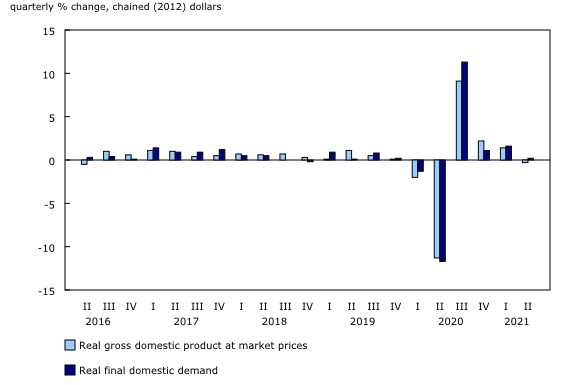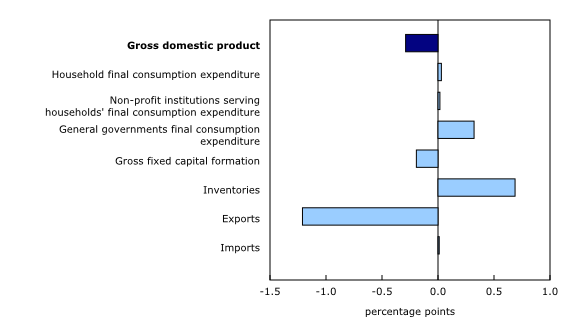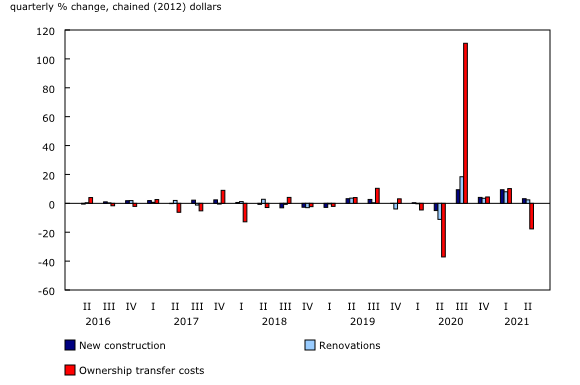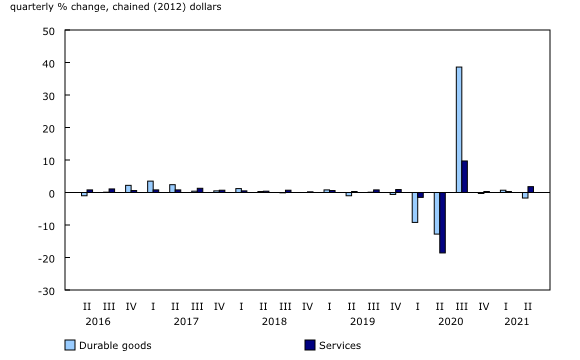Gross domestic product, income and expenditure, second quarter 2021
Archived Content
Information identified as archived is provided for reference, research or recordkeeping purposes. It is not subject to the Government of Canada Web Standards and has not been altered or updated since it was archived. Please "contact us" to request a format other than those available.
Released: 2021-08-31
Substantial declines in home resale activities and exports pushed real gross domestic product (GDP) down 0.3% in the second quarter of 2021. This contrasted with three consecutive quarterly increases that followed the sharp decline (-11.3%) caused by pandemic-related business shutdowns and travel restrictions in the second quarter of 2020.
Increases in investment in business inventories, government final consumption expenditures, business investment in machinery and equipment, and investment in new home construction and renovation were not sufficient to offset the declines in exports (-4.0%) and home ownership transfer costs (-17.7%), which include all costs associated with the transfer of a residential asset from one owner to another. Imports were flat in the second quarter.
Real gross national income rose 1.5%, reflecting gains from higher prices of exported crude oil and crude bitumen. Final domestic demand edged up 0.2%, following the 1.6% rise in the first quarter.
Businesses accumulated $9.7 billion in inventories, compared with a $6.2 billion withdrawal in the first quarter. The inventory accumulation, which was the major contributor to GDP during the quarter, was led by durable retail goods.
Housing investment reshapes the economy
Since the third quarter of 2020, housing investment has emerged as the predominant contributor to economic activities and to capital stock—with residential capital stock surpassing non-residential capital stock. Moreover, the average housing investment for the previous four quarters was 17% higher than the average over the last five years.
Both new construction and renovations—the components of residential capital stock—have shown sustained growth since the third quarter of 2020. Because of the ability to work from home, savings from less travel and reduced participation in other activities, low mortgage rates and increases in home equity lines of credit, spending has continued to increase on new houses (+3.2%) and home renovations (+2.4%).
After taking on $62.3 billion of residential mortgage debt in the last half of 2020, households added $84.2 billion more residential housing debt in the first half of 2021.
Household spending flat
Household spending, which rose 0.7% in the first quarter, edged up 0.1% in the second quarter. This reflected a drop in spending on goods—32 out of 48 categories of goods experienced decreases.
Outlays for durable goods declined in the quarter, as higher prices for many products constrained demand. With the easing of pandemic restrictions, outlays for services increased (+1.8%), led by food and beverage services (+4.3%).
Business investment in machinery and equipment rebounds
Business investment in machinery and equipment rose 5.7%, reflecting a sharp increase in investment in aircraft and other transportation equipment. This followed a sharp decline in the first quarter owing to a large disinvestment of used aircraft. Industrial machinery and equipment investment rose 4.8%, stemming from substantial imports.
Supply chain disruptions continue to impact motor vehicles
Shortages of microchips and other inputs curtailed trade in motor vehicles and domestic consumption. Household purchases of new passenger cars (-7.2%) and trucks, vans and sport utility vehicles (-1.6%) decreased, while business investment in medium and heavy trucks, buses and other motor vehicles fell 34.2%. Longer plant shutdowns because of international supply chain disruptions have constrained imports of parts and led to significant decreases in exports. Low production of motor vehicles and parts resulted in an 18.9% drop in exports of passenger cars and light trucks and an 8.7% decline in tires, motor vehicle engines and parts exports. Inventories had another quarter of significant drawdowns in response to supply needs.
Continued rises in prices and nominal gross domestic product
The GDP implicit price index, which reflects the overall price of domestically produced goods and services, rose 2.2% in the second quarter, driven by prices of construction materials and energy. This growth followed a 3.0% increase in the first quarter. Consequently, nominal GDP increased 1.9%.
Led by professional and personal services, construction, trade, and health and mining industries, compensation of employees rose 1.4%, reflecting heightened activity as lockdowns eased. Quebec (+2.8%), Alberta (+2.8%), and British Columbia (+1.5%) led the national wage increases in the second quarter.
Terms-of-trade improves and real gross national income rises
The terms-of-trade—that is, the ratio of the price of exports to the price of imports—was up 4.2%. This increase was led by a 4.9% increase in export prices, primarily a 17.7% increase in the price of exported crude oil and crude bitumen. Increased terms-of-trade contributed to higher real gross national income (+1.5%), which captures the real purchasing power of income earned by Canadian-owned production factors.
Double-digit household savings rate continues
The modest rise in household spending (+0.7%, in nominal terms) was outpaced by growth in disposable income (+2.2%) leaving households with more net savings than in the previous quarter. Household incomes were primarily bolstered by rising compensation of employees along with increasing transfers received from government, which were partially offset by a 2.8% rise in personal income taxes.
Consequently, the savings rate reached 14.2%—the fifth consecutive quarter with a double-digit savings rate—as various pandemic-related restrictions and uncertainty continued to limit the scope of household consumption. The household savings rate is aggregated across all income brackets; in general, savings rates are greater in higher income brackets.
Sustainable development goals
On January 1, 2016, the world officially began implementing the 2030 Agenda for Sustainable Development—the United Nations' transformative plan of action that addresses urgent global challenges over the following 15 years. The plan is based on 17 specific sustainable development goals.
Data on gross domestic product, income and expenditure are an example of how Statistics Canada supports the reporting on global sustainable development goals. This release will be used to measure the following goals:


Note to readers
Revisions
Data on gross domestic product (GDP) for the second quarter of 2021 have been released along with the revised data of the first quarter of 2021.
Support measures by governments
To alleviate the economic impact of the COVID-19 pandemic, governments implemented a number of programs, including the Canada Emergency Wage Subsidy and the Canada Emergency Response Benefit. For a comprehensive explanation of how government support measures were treated in the compilation of the estimates, see "Recording COVID-19 measures in the national accounts" and "Recording new COVID measures in the national accounts."
Details of some of the more significant government measures can be found on the page Federal government expenditures on COVID-19 response measures.
For information on seasonal adjustment, see Seasonally adjusted data – Frequently asked questions.
For more information on GDP, see the video "What is Gross Domestic Product (GDP)?"
Percentage change
Percentage changes for expenditure-based statistics (such as household spending, investment and exports) are calculated from volume measures that are adjusted for price variations. Percentage changes for income-based statistics (such as compensation of employees and operating surplus) are calculated from nominal values, that is, they are not adjusted for price variations.
Unless otherwise stated, growth rates represent the percentage change in the series from one quarter to the next; for instance, from the first quarter of 2021 to the second quarter of 2021.
Real-time tables
Real-time tables 36-10-0430-01 and 36-10-0431-01 will be updated on September 7.
Next release
Data on GDP by income and expenditure for the third quarter of 2021 will be released on November 30, 2021.
Products
The data visualization product "Gross Domestic Product by Income and Expenditure: Interactive tool," which is part of Statistics Canada – Data Visualization Products (71-607-X), is now available.
The document, "Recording new COVID measures in the national accounts," which is part of Latest Developments in the Canadian Economic Accounts (13-605-X), is available.
The document, "Recording COVID-19 measures in the national accounts," which is part of Latest Developments in the Canadian Economic Accounts (13-605-X), is available.
The Economic accounts statistics portal, accessible from the Subjects module of our website, features an up-to-date portrait of national and provincial economies and their structure.
The User Guide: Canadian System of Macroeconomic Accounts (13-606-G) is available.
The Methodological Guide: Canadian System of Macroeconomic Accounts (13-607-X) is available.
Contact information
For more information, or to enquire about the concepts, methods or data quality of this release, contact us (toll-free 1-800-263-1136; 514-283-8300; STATCAN.infostats-infostats.STATCAN@canada.ca) or Media Relations (613-951-4636; STATCAN.mediahotline-ligneinfomedias.STATCAN@canada.ca).
- Date modified:







